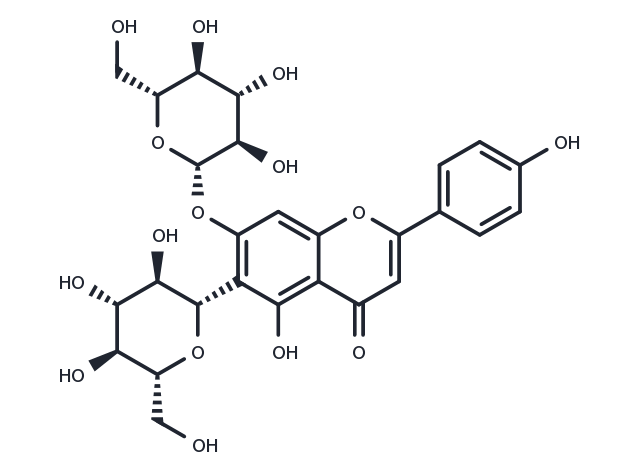store at low temperature,keep away from direct sunlight
Powder: -20°C for 3 years | In solvent: -80°C for 1 year

Saponarin (Petrocomoside) shows in vitro and in vivo hepatoprotective and antioxidant activity against CCl4-induced liver damage.

| Pack Size | Availability | Price/USD | Quantity |
|---|---|---|---|
| 1 mg | In stock | $ 72.00 | |
| 5 mg | In stock | $ 197.00 | |
| 10 mg | In stock | Inquiry | |
| 50 mg | In stock | Inquiry |

| Description | Saponarin (Petrocomoside) shows in vitro and in vivo hepatoprotective and antioxidant activity against CCl4-induced liver damage. |
| In vitro | In freshly isolated rat hepatocytes, paracetamol (100 μ mol) led to a significant decrease in cell viability, increased LDH leakage, decreased levels of cellular GSH, and elevated MDA quantity. Saponarin (60-0.006 μ g/mL) preincubation, however, significantly ameliorated paracetamol-induced hepatotoxicity in a concentration-dependent manner. The beneficial effect of Saponarin was also observed in vivo. Rats were challenged with paracetamol alone (600 mg/kg, i.p.) and after 7-day pretreatment with Saponarin (80 mg/kg, oral gavage). Paracetamol toxicity was evidenced by increase in MDA quantity and decrease in cell GSH levels and antioxidant defence system. No changes in phase I enzyme activities of AH and EMND and cytochrome P 450 quantity were detected. Saponarin pretreatment resulted in significant increase in cell antioxidant defence system and GSH levels and decrease in lipid peroxidation. The biochemical changes are in good correlation with the histopathological data. Protective activity of Saponarin was similar to the activity of positive control silymarin[1]. |
| Synonyms | Petrocomoside, Saponaretin-7-O-glucoside, Isovitexin-7-O-glucoside |
| Molecular Weight | 594.52 |
| Formula | C27H30O15 |
| CAS No. | 20310-89-8 |
store at low temperature,keep away from direct sunlight
Powder: -20°C for 3 years | In solvent: -80°C for 1 year
DMSO: 90 mg/mL (151.4 mM), Sonication is recommended.
You can also refer to dose conversion for different animals. More
bottom
Please see Inhibitor Handling Instructions for more frequently ask questions. Topics include: how to prepare stock solutions, how to store products, and cautions on cell-based assays & animal experiments, etc.
Saponarin 20310-89-8 Chromatin/Epigenetic MAPK Metabolism NF-Κb PI3K/Akt/mTOR signaling P450 NF-κB ERK AMPK Petrocomoside Saponaretin-7-O-glucoside Isovitexin-7-O-glucoside inhibitor inhibit
